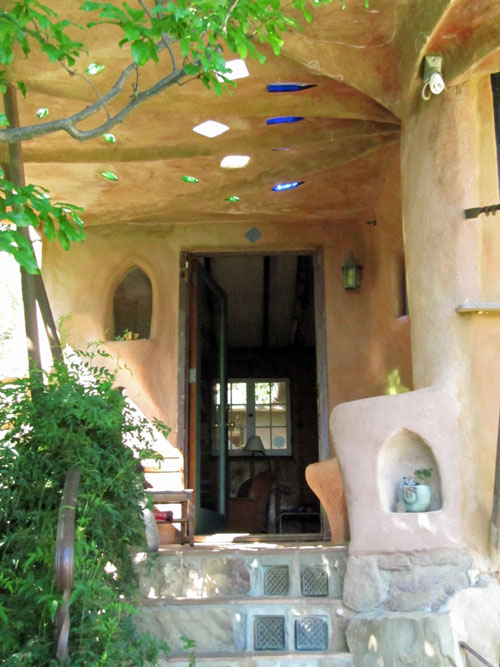We welcome a new contributor to Green Building Elements, Kata Polano, the owner of Earthen Built. Kata will be providing a regular column about Natural Building.
When I first heard the term “Natural Building” my imagination carried me across the globe, to the side of a street in India, where I saw an igloo-shaped mound of dirt and dung with a hole cut out for a door. Even then I was excited. The next moment I found myself mesmerized by the images that Google provided me after a quick search. I was both pleasantly surprised by their “normalness” and a bit disappointed by their lack of “exoticness”. That is, until I learnt that they were both.

Yes, natural buildings fall into both categories. Capable of passing themselves off as very conservative homes, or dazzling onlookers with their highly creative edges or curves, natural buildings can fit the style of just about anyone. If you want straight, flat walls, you can have them, if you want soft, curvaceous rooms, you can have that too. Really, one’s imagination is the limit.
Natural Building, yes, building with “dirt”, isn’t just some new fad. In fact, over half the world’s population still builds with earthen materials. Some of the world’s oldest buildings are made from the same dirt as is underfoot. Today’s natural buildings are a way to make ancient architecture new again. It is also a way to make our built environment healthy and expressive.
Through Natural Building one can quite literally “sculpt” their home. From curved walls, to domes, and even eagle-shaped fireplaces, Natural Building materials are readily formable to create some spectacularly interesting homes. You can even build yourself a small shoe shaped house, if you are so inclined, and boast about the small footprint your home has!
Natural buildings are good for the Earth. I know, that’s a bold claim, especially these days. So let me tell you why I can say this.
Firstly, natural builders and designers take the time to consider the land on which they build. They design with the natural landscape in mind, and pay close attention to weather patterns and the path of the sun at each site. Passive solar considerations are crucial to any good house design, and natural builders are especially keen to take advantage of free solar gains.
Secondly, natural buildings are constructed from raw, natural, and renewable resources, which are often also local. Any natural building will include clay, sand, fiber (usually straw), and water, while many will incorporate wood and stone as well. Some of these resources are even waste stream products, such as the straw and clay. All this ensures that the materials used in natural buildings have nearly no embodied energy.
As many of us know, the embodied energy of any given item or product includes all the energy gone into that product to create it and get it to the final consumer. With Natural Building many of the materials used to build a house can come from right on site, such as the clay dug up during the excavation. If you don’t have clay on your site, then chances are you can get clay from your local quarry, which got it from a local excavation. Even if you have to transport your natural materials to your site, you can feel good that there was little to no energy input in creating them. You just don’t “make” sand, unless you’re hardcore that way!
Even if you are not grinding your own sand, you can decide to bring it into your home. If you are planning to build a new home, you can make the big decision to build naturally. Codes may still require some aspects of your home to include concrete and/or metal, though the amount is hardly a fraction compared to standard conventional buildings, so don’t fret too much.
If you already have a home, and are planning a renovation, you can incorporate a number of Natural Building methods into a conventional home. This can even be as simple as including natural plasters on your walls instead of paint.
There are a number of Natural Building techniques available from which to choose. For instance: Cob, Adobe, Strawbales, Light Clay Infill, and Cobwood are perhaps the most well known, while Wattle & Daub is one of the most ancient and widely used in some countries. As a builder and designer myself, I usually recommend a hybrid of methods that are uniquely appropriate for various aspect of a home and landscape.
Finding someone in your area who can help you design and build your natural home or renovation is becoming easier every day. There are a few good online directories specific to natural building, such as The Natural Building Network. You may be surprised in who you find by asking around your neighborhood and community. Although not everyone has joined the Facebook community, there are great resources within it where you can find many builders and information as well.
Choosing to build with natural materials could just be the best decision you can make to ensure a healthy, beautiful, and comfortable home. Go ahead, get dirty, you’ll love it.
Author: Kata Polano is the owner/operator of Earthen Built, which specializes in the Artistry of Natural Building, Design, and Detail. She has been building with the earth since 2008, offering clients a healthy and creative alternative for their built environment. She currently lives on Vancouver Island, in British Columbia, Canada.
[source: http://feeds.importantmedia.org/~r/IM-greenbuildingelements/~3/Vw6xuj-_ypI/]

Leave a Reply
You must be logged in to post a comment.